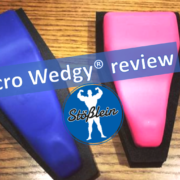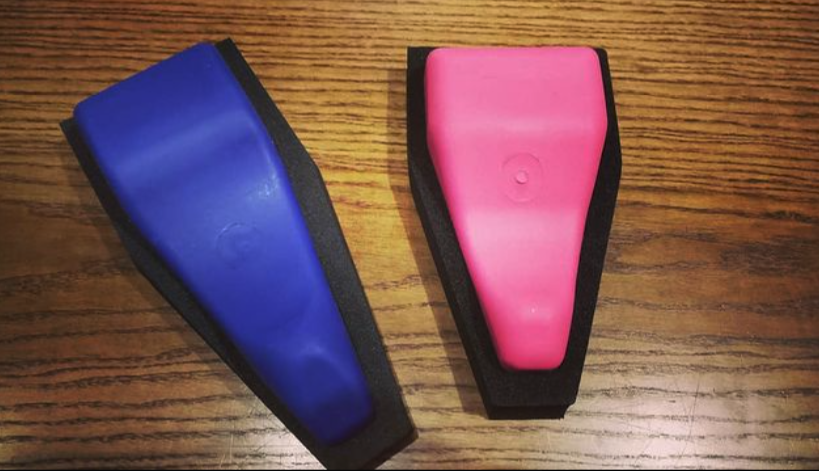Sacro Wedgy® is a special device, invented in the late 1950s by Football Coach Meares, to assist you with elevating your tail-bone and using gravitational force to relax, re-align and re-balance your hip. It might help releasing the “muscle of the soul”, the M. (Ilio)psoas, help stretch your M. piriformis and give your sciatic nerve a break from potentially being compressed- through structural disbalance. In this in-depth article I will give you my biggest take-aways and review after having used the Sacro Wedgy® (SW) for an extensive period.
Sacro Wedgy® – In a Nutshell explained
The Sacro Wedgy® is – as the name implies – a small rubber-like tool (see pictures) that can be used to release specific muscles, like the (Ilio)psoas and/or joint, e.g. the lumbosacral joints. I have corresponded with Cindy Littlefield, CEO of Sacrowedgy.com, the daughter of the inventor of the Sacro Wedgy®.
Cindy claims, that the Sacro Wedgy®:
“(…) helped lower back pain, hip pain, “pain in the butt”, common to runners, golfers, tennis players and all athletics (…) it has helped others with fibromyalgia, piriformis syndrome, scoliosis, knee pain, back pain, sciatica and more. The Sacro Wedgy® is not ALWAYS a quick fix, but it’s great when it is! The Sacro Wedgy® is a “tool” to use and like any “tool”, you will get out of it, what you put into it. You’re taking responsibility for your own back care.“ (Littlefield, 2021).
I first learned about the Sacro Wedgy® (SW) from Liz Koch. She’s the author of three fascinating books about the (Ilio)psoas, which you can learn more about in depth in my article.
Liz highly recommends this special device, that’s why I contacted Cindy.
Special thanks to Cindy Littlefield who sent me Sacro Wedgies for testing!
I really appreciate her approach, as she states, that it lies in your responsibility to take care of your (back)health.
Like many other “tools” the Sacro Wedgy® falls into the category: “use it or lose it”. That means, you cannot expect wonders if you have been suffering from pain for a long time, if you only use it once or twice!
Therefore, as you can read in the quotation above, the Sacro Wedgy® is not always a so called “quick fix.
Yet it is, from my perspective, a really wonderful “tool” for every therapist’s “toolbox”.
It could also be a “most bang for your buck” approach, especially when you want to use it for yourself and if your anatomical knowledge might be limited.
You can simply follow the instructions, don’t need a therapist from “the outside” who treats you, it can be taken almost everywhere (due to the small size and super lightweight) and it has an absolute reasonable price.
Actually it doesn’t have a price, but it is rather an investment! The best investment you can do in your life will always be in yourself, respectively your health.
My “Stoesslein Investment Advice”:
Invest in the best (=yourself).
This will bring you health,
The one who invests in oneself, will achieve more wealth!
Sacro Wedgy® – an anatomical excursion
The Sacro Wedgy® comes in two versions , a male and a female one. This takes care of the fact that there are slight anatomical differences between the hip of a man and a woman.
Some taller women and some women that just have a longer, narrower torso do better though on the male version!
In a nutshell, the Sacro Wedgies are special devices which isolate and elevate the sacrum and uses gravity help relax, aligned and re-balance from the hips out.
The word “sacrum” derives from Latin: sacer = holy, respectively sacr(o) à os sacrum (Becher et al., 1995).
The word “os” is also Latin and derives from ossis = bone (Becher et al., 1995).
So, literally translated “os sacrum” means: “cross-bone”.
The SW is also placed on your tail-bone (os coccygis). This “little fella” got its name from the old Greek term kokkyx = cuckoo (Becher et al., 1995).
“The sacrum (…) in human anatomy, is a large, triangular bone at the base of the spine that forms by the fusing of sacral vertebrae S1–S5 between 18 and 30 years of age.” (Kilincer et al., 2009).
Interesting fact:
“The os sacrum (sacred bone) was so named by the Romans as a direct translation from the older Greek hieron osteon. Explanations of the attribute “sacred” or “holy” in the past have included misinterpretation of the Greek word hieron, use of the bone in sacrificial rites, the role of the bone in protecting the genitalia (themselves considered sacred), and the necessity for the intactness of this bone as a nidus for resurrection at the Day of Judgment. A more plausible explanation may be that the holiness of the sacral bone was an attribute borrowed from the ancient Egyptians, who considered this bone sacred to Osiris, the god of resurrection and of agriculture.” (Sugar, 1987).
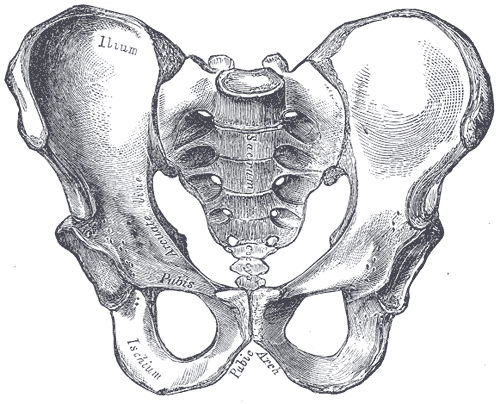
Cindy Littlefield says that:
Having revealed the etymological origin of the word Sacro Wedgy®, we now can dig into some more anatomical layers, as we are creatures who do not only consist of bones but also a lot of other living tissues.
Due to the fact that this is only a 2500 words blog article I cannot address every little detail concerning the work-mechanisms of the Sacro Wedgy® nor all the soft tissue that is involved, using this device. Please keep this in mind!
Nevertheless, I’d like to address some important muscles here, to give you an idea of how the Sacro Wedgy® is working and why I recommend using it.
Concerning this, let’s talk about the pear-shaped muscle, that actually doesn’t have the shape of a pear.
The so called “piriformis”.
This muscle “(…)originates with the wide end of the triangular shaped muscle attached to the front of the sacrum and the narrow end attached to the hip. As gravity takes over and the hips relax, the piriformis has a chance to stretch a little.” (Sacro Wedgy®, 2021).
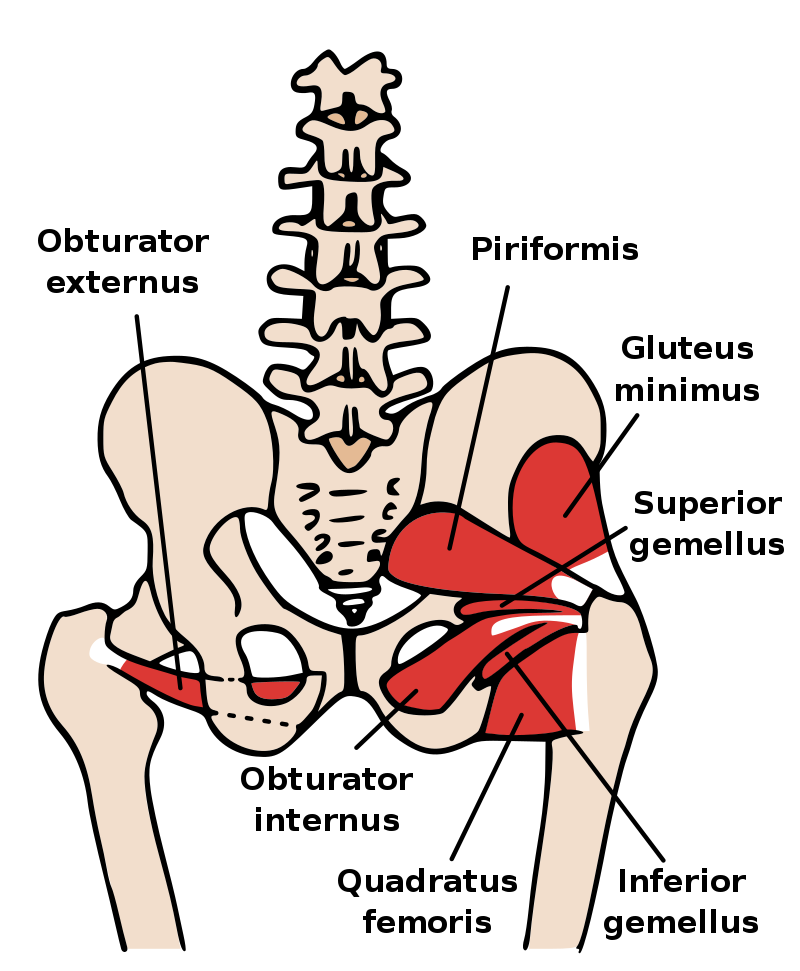
This is another confusing term. Piriformis derives from Latin pirum = pear (Becher et al., 1995).
If you look at the Musculus (M.) piriformis though, it rather looks like a triangle than a pear!
Interesting fact:
If you wonder why some muscles have names that are quite misrepresenting then please send you complains to the University of Padova, Italy. That’s where probably 90% of all these names derive. Furthermore it has the oldest permanent anatomical theatre in Europe, dating from 1595 and began teaching medicine around 1250! (Wikipedia, 2021).
Cindy writes:
“For some people, this (relaxation of the hip, annotation of me) is going to hurt like the devil so they have to relax even more. The sciatic nerve is involved with this muscle so you can understand how this has helped so many with sciatica. This muscle is also thought to be the beginning of a series of misalignments or what we call a “snowball” effect.” (Littlefield, 2021).
Sacro Wedgy® and the Sciatic Nerve
You have probably heard about the so called “Sciatic Nerve”. To give you a maximum of transparency, here’s the etymological decryption:
Sciatic derives from the old Greek word ischion = hip joint (Becher et al., 1995).
Therefore sciatic nerve describes the nerve that is trespassing the hip bone, descending into the lower extremities.
It is:
“(…) a large nerve in humans (…) which is the largest branch of the sacral plexus and runs alongside the hip joint and down the lower limb. It is the longest and widest single nerve in the human body, going from the top of the leg to the foot on the posterior aspect”. (Wikipedia, 2021).
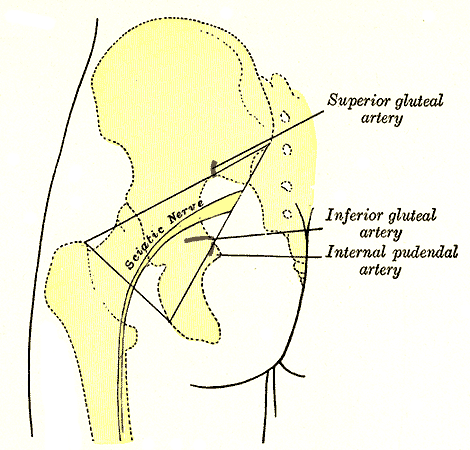
Regarding its function:
“The sciatic nerve supplies sensation to the skin of the foot, as well as the entire lower leg (except for its inner side). Sensation to skin to the sole of the foot is provided by the tibial nerve, and the lower leg and upper surface of the foot via the common peroneal nerve.” (Drake et al., 2005).
Besides being a Strength-Coach I do also work as a “Heilpraktiker” (Complementary and Alternative Medicine Practitioner) in Germany.
Due to my observations from clients and patients, I can says that the sciatic nerve is commonly blocked through misalignment, respectively structural disbalances, which will often result in great pain!
These are symptoms of different causations, including emotional anatomy!
I see the value in the Sacro Wedgy® as it gives patients/clients the opportunity to continue their treatment at home, on their own. This will enhance a manual treatment and will bring back health in “the own hands” of people instead of being conditioned that some external “authority” will cure their diseases!
How to use a Sacro Wedgy® ?
In this article I will focus on how to use the Sacro Wedgy®. If you’re also looking for some isometric exercise you might include around using the SW you will find some instructions on the SW company’s site.
Sitting on the Sacro Wedgy® (during strength training)
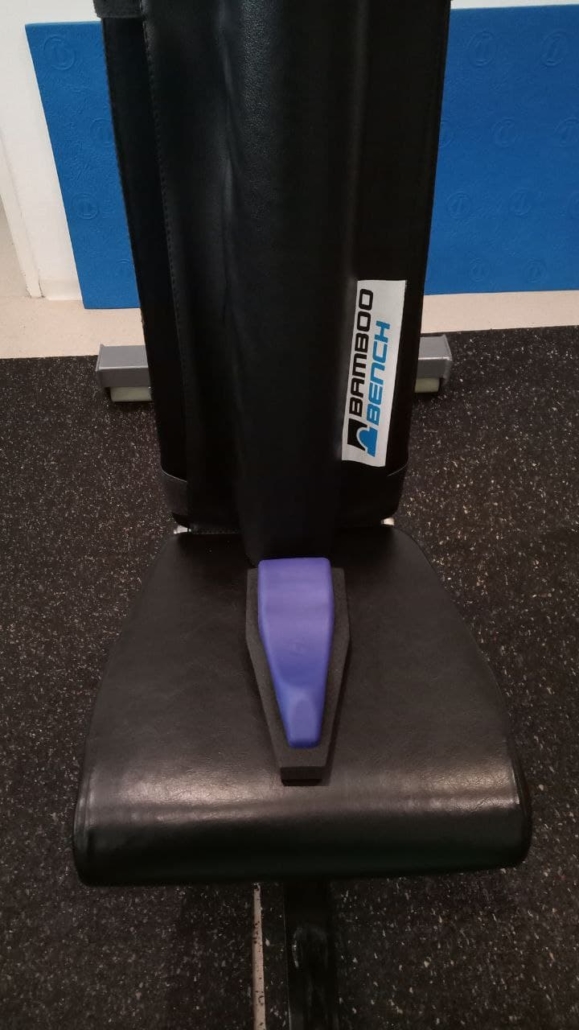
Lower back problems, sciatica and leg pain do often start after having been on a long trip, and/or sitting for prolonged periods.
The Sacro Wedgy company writes:
“Years ago many seats had a small hump in the middle. Farm tractor seats or older secretarial furniture are examples. What this hump was doing was filling in the gap under the coccyx (tailbone) and about 40 years ago the design changed to the bucket seat. After sitting for a while, gravity takes over, slumping starts and the spinal column pushes the sacrum down causing the hips to spread and pain begins. You will recieve most of your correction and relief from lying down on the Sacro Wedgy® with a neck support, but we like to recommend sitting on the Sacro Wedgy® for preventive maintence.” (Sacro Wedgy®, 2021).
As I mentioned earlier, I’ve been experimenting quite a lot with the SW. I also included it into my strength training.
Regarding the quote above, I thought “well, let’s see if this will add any benefits”. And, it did!
In a nutshell: you can use the SW during any exercise in which you have to sit on a machine, bench, whatsoever.
The most benefit however will probably occur while overhead pressing movements or, at least, exercises where gravity is pushing you down into a seat, respectively the Sacro Wedgy® (see pictures of example exercises).
Klick on the link to Instagram below the screenshot and you can see me performing seated dumbbell presses, sitting on the Sacro Wedgy® and with my BAMBOO BENCH®.
Lying on the Sacro Wedgy®
Obviously you might experience the biggest benefit of the Sacro Wedgy® by lying on it. I, for myself, especially like to use it before/after a leg workout and while lying on my back during a coffee enema.
Lying on the Sacro Wedgy® is the most efficient way of using this tool for helping muscles (in the hip area) return to a better structural balance.
Please consider the neck to be stabilized, too, with a sufficient firm support.
Place the Sacro Wedgy® under only the sacrum to isolate, cradle and elevate this very important “wedged” shape bone between your hips.
“The beginning stages may, for some, be awkward. Just finding the “sacrum” may be daunting. It is below the waist, shaped like a triangle with a curve at the very end sometimes called the “tailbone”. Lying on the SACRO WEDGY® is like lying on top of another sacrum. There is a curve or “cradle” in the SACRO WEDGY® similar to the curve of the sacrum.” (Sacro Wedgy®, 20221).
As mentioned above, I first learned about the SW from Liz Koch who recommends using it during a position called “constructive rest position”.
According to that, I’d suggest to start using the SW while keeping your knees bent with feet on the floor (in a “constructive rest position”) and with the hands move the SW up towards the waist and down to the feet ½ inch (approximately 1,27cm) at a time until you feel the “cradle” (see pictures).
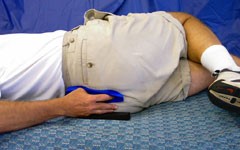
Sacro Wedgy® Conclusion
To make a long story short: I do recommend to use a Sacro Wedgy®! Of course, you should consult a physician first!
Being a Strength-Coach and a “Heilpraktiker” (Complementary and Alternative Medicine Practictioner) I do see the benefits of using a little “helper” like the Sacro Wedgy®.
You might use it during treatment, to increase the efficiency and/or e.g. around (before/after) a leg workout.
It (the SW) might therefore be used as well as preventive as rehabilitative. Moreover, it serves as a subtle (Ilio)psoas releaser.
The Sacro Wedgy® has a reasonable price and follows the “Pareto-Principle”, respectively the 20:80 rule.
Will the SW “cure” all your back-problems? Certainly not. But, it might fall into the 20% range of things you can do by yourself to achieve 80% of better back-health.
Especially, if you’re suffering from hip pain. Of course you will always have to question yourself what led to these problems and how YOU can solve them! Nobody and nothing will be able to “cure” yourself.
All “cool tools” and therapists are only able to give help for self-help! Keep this in mind!
© HP Bernd Stößlein, Master of Business Administration in Sports Management.
If you liked this article, then subscribe to the blog / newsletter, leave a comment or contact me.
In this and other articles you will find one or the other “affiliate link” to amazon. If you purchase something through this link, you will support my blog articles and create resources for further high-quality research and articles like this. There are no additional costs for you! You can find all of my basic recommendations at: https://www.amazon.de/shop/bernd_stoesslein
Literature
Sacro Wedgy®, source: https://www.sacrowedgy.com/store/, access from: 30.5.2021.
Lateinisch-griechischer Wortschatz in der Medizin, p. 105.
Lateinisch-griechischer Wortschatz in der Medizin, p. 113..
Lateinisch-griechischer Wortschatz in der Medizin, p. 153.
Lateinisch-griechischer Wortschatz in der Medizin, p. 170.
Lateinisch-griechischer Wortschatz in der Medizin, p. 193.
Kilincer, Cumhur; et al. (2009). “Sacrum anatomy”. Scientific spine. Trakya Üniversitesi Rektörlüğü, Yerleşkesi, 22030 Edirne, Turkey: Self. Retrieved 8 November 2015.
University of Padova, source: https://en.wikipedia.org/wiki/University_of_Padua, access: 30.5.2021.
Sciatic Nerve, source: https://en.wikipedia.org/wiki/Sciatic_nerve#cite_note-1, access: 30.5.2021.
Drake, Richard L.; Vogl, Wayne; Tibbitts, Adam W.M. Mitchell; illustrations by Richard; Richardson, Paul (2005). Gray’s anatomy for students. Philadelphia: Elsevier/Churchill Livingstone.
How the Sacrum Got Its Name, Oscar Sugar, JAMA. 1987;257(15):2061-2063. doi:10.1001/jama.1987.03390150077038.
Pictures
Sciatic Nerve: Henry Vandyke Carter und ein weiterer Urheber – Henry Gray (1918) Anatomy of the Human Body (See “Buch” section below) Bartleby.com: Gray’s Anatomy, Tafel 1244; File:Gray1244.png, Erstellt: vor 1858 date QS:P,+1858-00-00T00:00:00Z/7,P1326,+1858-00-00T00:00:00Z/9, Ungefährer Verlauf des Ischiasnervs (Nervus ischiadicus), im Bild mit Sciatic Nerve beschriftet, source: https://de.wikipedia.org/wiki/Ischialgie#/media/Datei :Gray1244.png, access from: 9.6.21.
Posterior view of gluteal region showing the small gluteal muscles and gluteus minimus. CC BY-SA 3.0, File: Posterior Hip Muscles 1.svg, Erstellt: 29. September 2017. Source: https://de.wikipedia.org/wiki/Musculus_piriformis#/media/Datei:Posterior_Hip_Muscles_1.svg, access from: 9.6.21.
Henry Vandyke Carter und ein weiterer Urheber – Henry Gray (1918) Anatomy of the Human Body (See “Buch” section below) Bartleby.com: Gray’s Anatomy, Tafel 241, Sourece: https://de.wikipedia.org/wiki/Kreuzbein#/media/Datei:Gray241.png, access from: 9.6.21.

